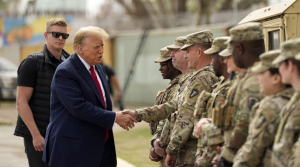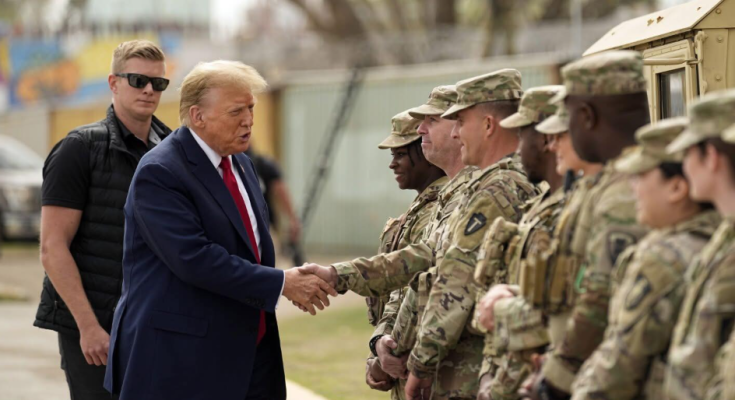Trump Deploys U.S. Marines: A New Chapter in Power, Pressure, and Provocation
In the waning days of summer 2025, a headline began to ripple across screens and social feeds: “Trump Deploys U.S. Marines to the Caribbean.” What initially seemed like a strategic maneuver quickly escalated into a geopolitical storm, drawing sharp reactions from allies, adversaries, and citizens alike. The deployment, framed by the administration as a crackdown on transnational drug cartels, has ignited fierce debate—not only about its legality and intent, but about the deeper implications of military power in a world already teetering on edge.
At the heart of the operation is Venezuela. President Nicolás Maduro, long at odds with the United States, responded to the deployment with fury and defiance. “We are prepared to declare a republic in arms,” he warned during a press conference in Caracas, accusing the U.S. of pointing “1,200 missiles” at his country. His words were not mere rhetoric—they were a signal of readiness, of resistance, and of a nation bracing for confrontation.
The U.S. Navy, under Trump’s directive, surged its presence in the region. Warships like the USS Gravely, USS Jason Dunham, and USS Lake Erie were joined by amphibious assault ships carrying over 4,000 sailors and Marines. The official line was clear: this was about dismantling drug networks, particularly the notorious Tren de Aragua gang, which had allegedly been smuggling narcotics into U.S. waters. But the scale of the deployment—and the timing—suggested something more.
On September 2, the tension reached a boiling point. A U.S. Navy airstrike targeted a small boat in the Southern Caribbean, reportedly killing 11 suspected smugglers. President Trump, never one to shy away from dramatic flair, announced the strike during an Oval Office press briefing. “We just shot out a boat,” he said, flanked by Secretary of Defense Pete Hegseth and Vice President JD Vance. “A lot of drugs in that boat. Let this serve as notice.”
The footage, grainy and black-and-white, showed the vessel moments before impact. It was a stark, sobering image—one that blurred the line between justice and escalation. Critics argued that the strike risked inflaming tensions with Venezuela, whose government immediately denounced the footage as fake and accused the U.S. of violating international law.
But the Caribbean wasn’t the only theater of Trump’s military assertiveness. Back home, controversy brewed over his domestic deployments. In June, Trump had sent 4,000 National Guard troops and 700 active-duty Marines to Los Angeles amid protests over immigration raids. The move was met with outrage from California officials, who sued the administration for violating the Posse Comitatus Act—a law that restricts the use of federal troops in domestic law enforcement.
A federal judge ruled the deployment illegal, citing Trump’s own statements about using the military to “do anything I want to do” if he deemed the country in danger. The ruling was a blow to the administration, but Trump remained defiant, appealing the decision and hinting at further deployments to cities like Chicago and Boston.
The dual deployments—one abroad, one at home—paint a portrait of a presidency unafraid to wield military power as both sword and shield. For Trump, the Marines are not just a branch of the armed forces—they are a symbol of control, of dominance, and of his vision for a “strong America.” But for many, they are also a symbol of overreach, of blurred boundaries, and of a democracy under strain.
In Venezuela, the stakes are existential. Maduro, facing internal dissent and economic collapse, has used the U.S. deployment to rally nationalist sentiment. His government has mobilized troops along the coast, urged civilians to join militias, and accused the U.S. of orchestrating regime change. Opposition leaders, meanwhile, have welcomed the pressure, describing Maduro’s regime as a “criminal enterprise” and thanking Trump for his actions.
The international community watches with unease. Latin American nations, wary of U.S. interventionism, have called for restraint. Human rights organizations warn of civilian casualties and unintended consequences. And within the U.S., voices across the political spectrum question the wisdom of military escalation in a region already scarred by decades of conflict.
Yet amid the chaos, there is a quieter story—one of the Marines themselves. Young men and women, many barely out of high school, now find themselves deployed to volatile waters and uncertain missions. For them, the headlines are distant echoes. What matters is the camaraderie, the discipline, and the sense of duty that binds them. They are not politicians. They are not strategists. They are boots on the ground, navigating the fog of war with courage and resolve.
And then there are the families—watching, waiting, hoping. For every deployment, there is a mother checking her phone for updates, a spouse counting the days, a child drawing pictures of ships and stars. The human cost of military action is not measured in missiles or maps—it is measured in moments, in memories, in the quiet ache of absence.
As September unfolds, the world holds its breath. Will the Caribbean deployment lead to further strikes? Will domestic courts rein in presidential power? Will Venezuela erupt into conflict, or find a path to peace?
No one knows for sure. But one thing is clear: the deployment of U.S. Marines under Trump is more than a tactical maneuver. It is a statement—a declaration of intent, of ideology, and of the complex dance between strength and restraint.
In the end, the story is not just about Trump, or Maduro, or the Marines. It is about the choices we make when faced with fear. It is about the lines we draw between protection and provocation. And it is about the enduring question that haunts every democracy: how far is too far?


